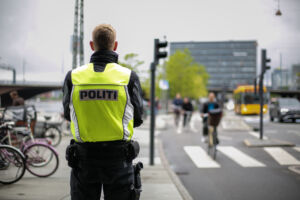News
Police launch one-week campaign targeting road-users who jump red lights
This article is more than 2 years old.
Male cyclists aged 18 to 35 in the Capital Region are the worst culprits, according to survey

Not the most welcome sight in the world! (photo: Rådet for Sikker Trafik)
Continuing at a red light, particularly if you are turning right on your bicycle, or passing through a pedestrian crossing on a seemingly deserted street, might seem like the natural thing to do.
But this week, traffic crimes like these will more likely than normal land you a large fine, as the police will be running a campaign to catch as many cyclists running red lights as possible.
According to a recent Rådet for Sikker Trafik study of 3,266 adults, 41 percent of cyclists confess to illegally turning right at red lights, while 8 percent admit to pedalling through conventional red lights.
Men aged 18 to 35 in the Capital Region are the worst culprits. In the Capital Region, one in eight cyclists admit to routinely cycling through red lights – and 19 percent of 18 to 35-year-olds.
Motorists too
The Week 21 campaign will also be aiming to catch motorists who drive through red lights.
Another recent Rådet for Sikker Trafik study, in collaboration with Wilke, reveals that 11 percent have run a red light in the last year.
Again, Copenhagen is the most likely region in which the crime is committed, with 17 percent confessing – a figure matched by the capital’s Vestegn suburbs.
Some 5,070 motorists were questioned for the survey last year.
Notorious trouble spots
Certainly, fining cyclists and motorists can be a very profitable business.
On April 17, thanks to a trap at the bottom of a one-way street linking Gammel Kongevej to Vesterbrogade under the Ny Teater, the police caught 23 cyclists in just one hour, fining them 1,000 kroner each.
The spot is one of several notorious junctions in the capital where it is easy to make an honest mistake – a similar one-hour operation, where cyclists defied a ‘No Entry’ sign at Griffenfeldsgade in Nørrebro in late April, yielded 36,000 kroner.
Another is by ‘The Anchor’ at Nyhavn where the close proximity of the red lights often causes logjams among cyclists during busy times as they battle to find the space needed to move onto the next queue.










































